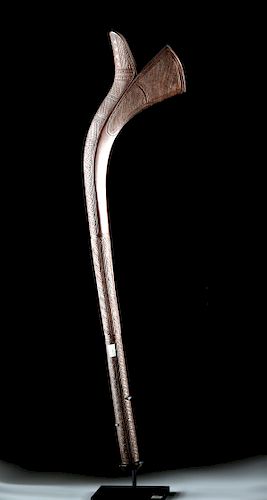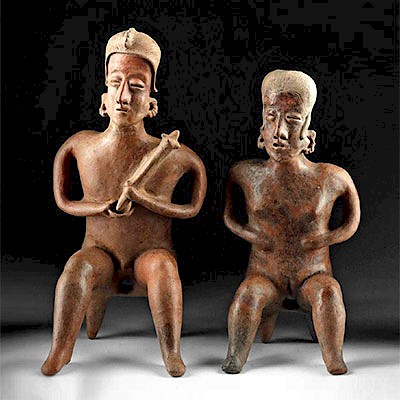Late 19th C. Fijian Wooden Sali War Club
Lot 167a
About Seller
Artemis Fine Arts
686 S Taylor Ave, Ste 106
Louisville, CO 80027
United States
Selling antiquities, ancient and ethnographic art online since 1993, Artemis Gallery specializes in Classical Antiquities (Egyptian, Greek, Roman, Near Eastern), Asian, Pre-Columbian, African / Tribal / Oceanographic art. Our extensive inventory includes pottery, stone, metal, wood, glass and textil...Read more
Estimate:
$2,000 - $3,000
Absentee vs Live bid
Two ways to bid:
- Leave a max absentee bid and the platform will bid on your behalf up to your maximum bid during the live auction.
- Bid live during the auction and your bids will be submitted real-time to the auctioneer.
Bid Increments
| Price | Bid Increment |
|---|---|
| $0 | $25 |
| $300 | $50 |
| $1,000 | $100 |
| $2,000 | $250 |
| $5,000 | $500 |
| $10,000 | $1,000 |
| $20,000 | $2,500 |
| $50,000 | $5,000 |
| $100,000 | $10,000 |
| $200,000 | $20,000 |
About Auction
By Artemis Fine Arts
May 23, 2019
Set Reminder
2019-05-23 10:00:00
2019-05-23 10:00:00
America/New_York
Bidsquare
Bidsquare : Exceptional Day 2 Ethnographic Tribal Fossils
https://www.bidsquare.com/auctions/artemis-gallery/exceptional-day-2-ethnographic-tribal-fossils-4136
Day 2 of an important 2-day auction featuring exceptional ethnographic art from around the world. Today's sale will feature Pre-Columbian from the ancient americas, Native American, African / Tribal, Oceanic, Spanish Colonial, and incredible Fossils. Artemis Fine Arts info@artemisgallery.com
Day 2 of an important 2-day auction featuring exceptional ethnographic art from around the world. Today's sale will feature Pre-Columbian from the ancient americas, Native American, African / Tribal, Oceanic, Spanish Colonial, and incredible Fossils. Artemis Fine Arts info@artemisgallery.com
- Lot Description
Oceania, Fiji Islands, ca. late 19th to early 20th century CE. A beautiful example of this distinctive double-headed war club known as a "sali." Sometimes referred to as "cali," "tebetebe," or "gunstock clubs," this style of war club is recognizable based on the wide cheeks of the striking head as well as the pronounced spur situated above. The entire surface is highly polished which imbues the finely-incised linear and geometric motifs cross-hatched into the club face and down the entire handle with a greater sense of definition. Weapons like this have both ceremonial and functional roles, and their forms were cultivated from living trees. The ridges were beaten into the tree while it was still growing to allow the curved shape to arise "naturally" instead of having to be later carved. Lacking a cutting edge, this weapon was likely used in either close combat or in dance performances. Size: 11.5" W x 36.9" H (29.2 cm x 93.7 cm); 39.4" H (100.1 cm) on included custom stand.
For a similar example, please see The Metropolitan Museum of Art, accession number 1979.206.1390: https://metmuseum.org/art/collection/search/313583
A similar example hammered for $13,750 at Sotheby's, New York "African, Oceanic and Pre-Columbian Art" Auction (May 14, 2010, lot 71): http://www.sothebys.com/en/auctions/ecatalogue/2010/african-oceanic-and-pre-columbian-art-n08638/lot.71.html
Provenance: private Newport Beach, California, USA collection
All items legal to buy/sell under U.S. Statute covering cultural patrimony Code 2600, CHAPTER 14, and are guaranteed to be as described or your money back.
A Certificate of Authenticity will accompany all winning bids.
We ship worldwide and handle all shipping in-house for your convenience.
#136116Very light abrasions to handle body and head, with old streak of yellow pigment along body, otherwise intact and near-choice. Light earthen deposits within some incised details. Old inventory label on handle.Condition
- Shipping Info
-
All shipping is handled in-house for your convenience. Your invoice from Artemis Gallery will include shipping calculation instructions. If in doubt, please inquire BEFORE bidding for estimated shipping costs for individual items.
-
- Buyer's Premium



 EUR
EUR CAD
CAD AUD
AUD GBP
GBP MXN
MXN HKD
HKD CNY
CNY MYR
MYR SEK
SEK SGD
SGD CHF
CHF THB
THB














